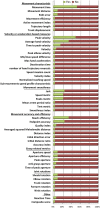Quantifying Quality of Reaching Movements Longitudinally Post-Stroke: A Systematic Review
- PMID: 35100897
- PMCID: PMC8902693
- DOI: 10.1177/15459683211062890
Quantifying Quality of Reaching Movements Longitudinally Post-Stroke: A Systematic Review
Abstract
Background: Disambiguation of behavioral restitution from compensation is important to better understand recovery of upper limb motor control post-stroke and subsequently design better interventions. Measuring quality of movement (QoM) during standardized performance assays and functional tasks using kinematic and kinetic metrics potentially allows for this disambiguation.
Objectives: To identify longitudinal studies that used kinematic and/or kinetic metrics to investigate post-stroke recovery of reaching and assess whether these studies distinguish behavioral restitution from compensation.
Methods: A systematic literature search was conducted using the databases PubMed, Embase, Scopus, and Wiley/Cochrane Library up to July 1st, 2020. Studies were identified if they performed longitudinal kinematic and/or kinetic measurements during reaching, starting within the first 6 months post-stroke.
Results: Thirty-two longitudinal studies were identified, which reported a total of forty-six different kinematic metrics. Although the majority investigated improvements in kinetics or kinematics to quantify recovery of QoM, none of these studies explicitly addressed the distinction between behavioral restitution and compensation. One study obtained kinematic metrics for both performance assays and a functional task.
Conclusions: Despite the growing number of kinematic and kinetic studies on post-stroke recovery, longitudinal studies that explicitly seek to delineate between behavioral restitution and compensation are still lacking in the literature. To rectify this situation, future studies should measure kinematics and/or kinetics during performance assays to isolate restitution and during a standardized functional task to determine the contributions of restitution and compensation.
Keywords: behavioral restitution; biomechanics; compensation; kinematics; longitudinal studies; reaching; recovery; stroke; systematic review; upper extremity.
Conflict of interest statement
Figures



Similar articles
-
Systematic Review on Kinematic Assessments of Upper Limb Movements After Stroke.Stroke. 2019 Mar;50(3):718-727. doi: 10.1161/STROKEAHA.118.023531. Stroke. 2019. PMID: 30776997
-
Predicting post-stroke motor recovery of upper extremity using clinical variables and performance assays: A prospective cohort study protocol.Physiother Res Int. 2022 Apr;27(2):e1937. doi: 10.1002/pri.1937. Epub 2022 Jan 17. Physiother Res Int. 2022. PMID: 35037341
-
Upper limb kinematics during the first year after stroke: the stroke arm longitudinal study at the University of Gothenburg (SALGOT).J Neuroeng Rehabil. 2020 Jun 15;17(1):76. doi: 10.1186/s12984-020-00705-2. J Neuroeng Rehabil. 2020. PMID: 32539738 Free PMC article.
-
End-point kinematics using virtual reality explaining upper limb impairment and activity capacity in stroke.J Neuroeng Rehabil. 2019 Jul 1;16(1):82. doi: 10.1186/s12984-019-0551-7. J Neuroeng Rehabil. 2019. PMID: 31262320 Free PMC article.
-
Smoothness metrics for reaching performance after stroke. Part 1: which one to choose?J Neuroeng Rehabil. 2021 Oct 26;18(1):154. doi: 10.1186/s12984-021-00949-6. J Neuroeng Rehabil. 2021. PMID: 34702281 Free PMC article.
Cited by
-
Identification of inverse kinematic parameters in redundant systems: Towards quantification of inter-joint coordination in the human upper extremity.PLoS One. 2022 Dec 16;17(12):e0278228. doi: 10.1371/journal.pone.0278228. eCollection 2022. PLoS One. 2022. PMID: 36525415 Free PMC article.
-
Using Wearable Inertial Sensors to Estimate Clinical Scores of Upper Limb Movement Quality in Stroke.Front Physiol. 2022 May 3;13:877563. doi: 10.3389/fphys.2022.877563. eCollection 2022. Front Physiol. 2022. PMID: 35592035 Free PMC article.
-
Hip and trunk kinematics during reaching on a mobile and stable seat.PLoS One. 2023 Jul 27;18(7):e0289115. doi: 10.1371/journal.pone.0289115. eCollection 2023. PLoS One. 2023. PMID: 37498910 Free PMC article.
-
Upper extremity kinematics: development of a quantitative measure of impairment severity and dissimilarity after stroke.PeerJ. 2023 Dec 8;11:e16374. doi: 10.7717/peerj.16374. eCollection 2023. PeerJ. 2023. PMID: 38089910 Free PMC article.
-
Psychometric Properties of a New Measure of Upper Limb Performance in Post-Stroke Individuals: Trunk-Based Index of Performance.Neurorehabil Neural Repair. 2023 Jan;37(1):66-75. doi: 10.1177/15459683221143462. Epub 2022 Dec 28. Neurorehabil Neural Repair. 2023. PMID: 36575955 Free PMC article.
References
-
- Lawrence ES, Coshall C, Dundas R, et al. Estimates of the prevalence of acute stroke impairments and disability in a multiethnic population. Stroke. 2001;32:1279-1284. - PubMed
-
- Langhorne P, Bernhardt J, Kwakkel G. Stroke rehabilitation. Lancet. 2011;377:1693-1702. - PubMed
-
- Pollock A, St George B, Fenton M, Firkins L. Top 10 research priorities relating to life after stroke - consensus from stroke survivors, caregivers, and health professionals. Int J Stroke. 2014;9:313-320. - PubMed
-
- Duncan PW, Goldstein LB, Matchar D, Divine GW, Feussner J. Measurement of motor recovery after stroke. Outcome assessment and sample size requirements. Stroke. 1992;23:1084-1089. - PubMed
Publication types
MeSH terms
LinkOut - more resources
Full Text Sources
Medical

